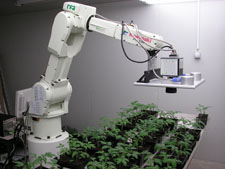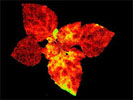|
|
Imaging Technology
Fluorescence imaging is a non-invasive technique, which enables you to visualise and to quantify the effects of agrochemicals and pathogens on the photosynthesis. Fluorescence imaging is an outstanding tool for demonstrating the effects of formulation, adjuvants and application technology on the performance of agrochemicals. The offered applications of fluorescence technology have been developed by Plant Research International and SURfaPLUS in Wageningen. Interested in a possible project, please contact Hans de Ruiter.
Fluorescence facility
Optimising formulations or adjuvantsThe fluorescence facility visualises and quantifies quite well the effect of a surfactant (used as adjuvant to improve the pesticide activity) on the performance of bentazone and glyphosate. To optimise surfactant type and concentration, this fluorescence approach can be applied to monitor what happens in the plant. Phytotoxic effects of surfactants themselves can also be visualised. In addition to the visualization of effects, the technology enables you to quantify formulation effects on the day of treatment (inhibitors photosynthesis and for instance glufosinate) or within 2-3 days (glyphosate). This quantification correlates quite well with growth inhibition.
Other applications of fluorescence technology
About Plant Research International and SURfaPLUS R&DPlant Research International developed the fluorescencence technology. SURfaPLUS R&D has access to this technolgy for the development and testing of more effective formulations and adjuvants for agrochemicals. See also our publications on fluorescence in the list of publications. ContactIf this webpage raises your interest, please contact Dr. Hans de Ruiter (SURfaPLUS R&D) or Dr. Henk Jalink (Plant Research International) . |
Robotised system for fluorescence imaging
Adjuvant effect on glyphosate activity
Glyphosate activity imaging without (left) and with adjuvant (right) 96 h after treatment.
Adjuvant effect on bentazon activity
Bentazone activity imaging without (left) and with adjuvant (right) 2 h after treatment.
Also see the movie demonstrating the effect of two adjuvants on bentazone activity
Phytotoxic adjuvant
Phytotoxic adjuvant effect in colour (left) and via imaging (right) 48 h after treatment.
Imaging effect of nozzle type
Bentazone activiy after application with a fine (left) and a coarse nozzle (right) 72 h after treatment; coarse nozzle (XR 8005) is more effective. |









